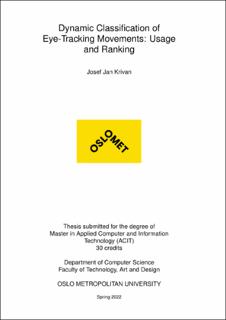| dc.description.abstract | Eye-tracking including its uses, research and progression has seen much growth over the years, especially in the medical field. With this naturally comes many challenges, such as proper application in numerous fields as well as the directions to take the technology towards and what is best to focus on with such a versatile field.
In our case, we discuss the randomness of eye-patterns, the distinguishing of the different eye-movement types and how best to categorize these movements correctly. This research is especially important since, the correct classification of these distinct eye movements is vital for fields such as medicine and psychology, specifically in the field of medical diagnosis.
The main methods for distinguishing these eye features is through the use of algorithms, designed to find patterns in movement properties, eventually classifying the features. The research for this thesis as well as its writing was done entirely between January and May 2022. In this time, different approaches were used, first by analysing the eye-tracker data with its corresponding algorithm, and then moving onto robust, established methods within the field such as velocity and dispersion threshold-based algorithms.
Through testing, it was determined that the basic I-VT velocity based algorithm turned out to be the best result, despite being the most simplistic algorithm implemented. | en_US |
